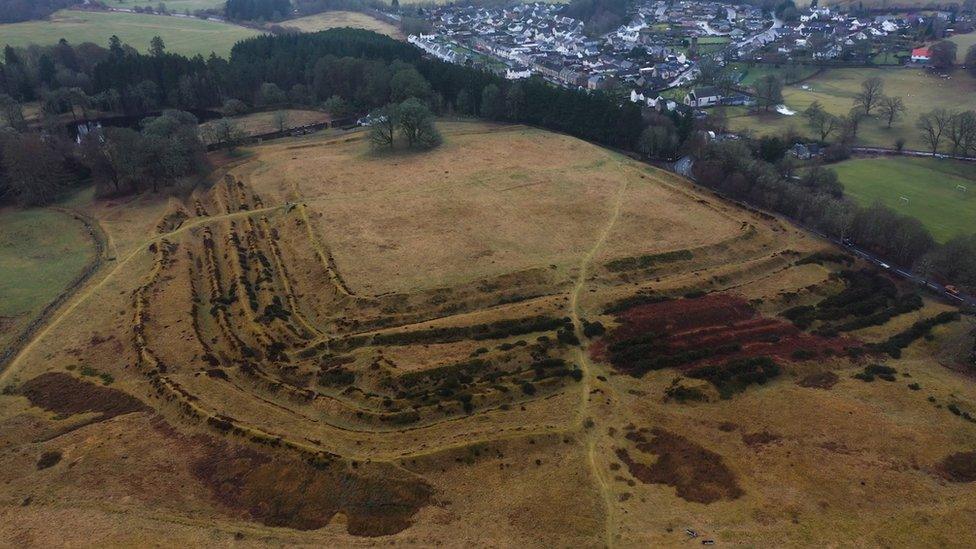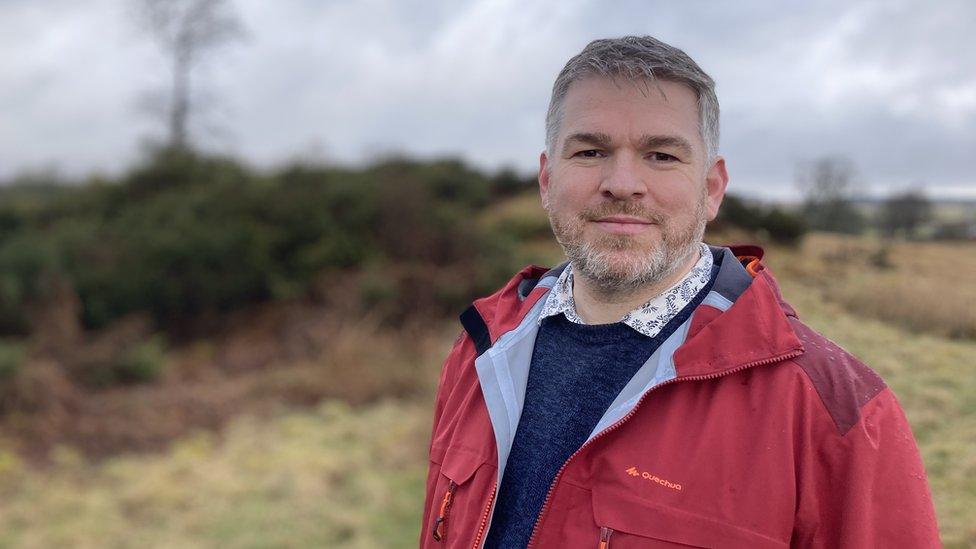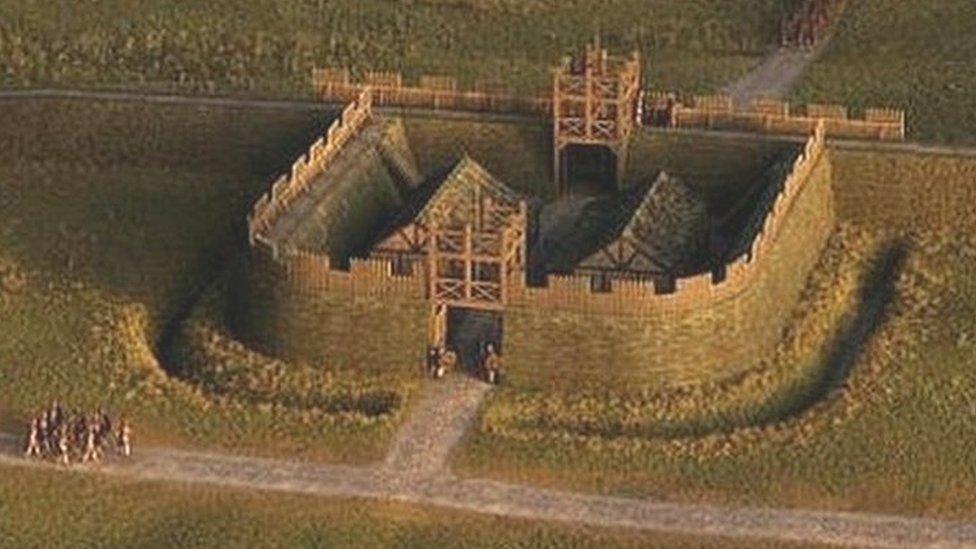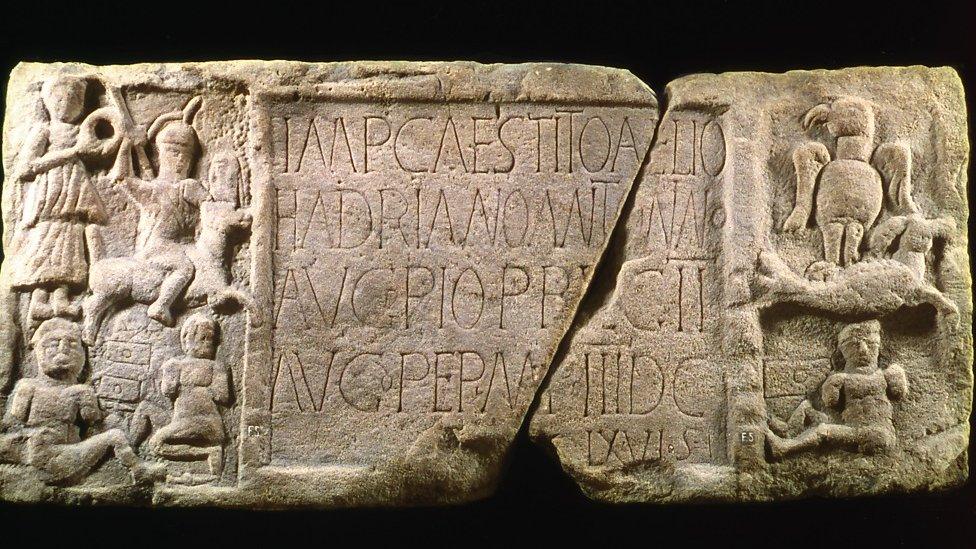Tracing Scotland's unique place in the Roman world
- Published
Exploring the legacy of the Romans in Scotland from the air
It is a commonly-held view that the Romans did not spend a long time in Scotland or have much interest in it - but new research is highlighting the extraordinary extent of what they built and their persistence in trying to subdue the Caledonian tribes.
Dr Andrew Tibbs, an honorary research fellow in archaeology at Durham University, has carried out a digital survey of almost 100 sites thought to be linked with the first invasion of Scotland in the decade after 70AD.
It happened at a time when the Romans may have thought they could conquer the whole of the country and before they built Hadrian's Wall and the later Antonine Wall in a bid to secure the empire's north-western border.
Dr Tibbs says: "For the Romans, campaigning in Scotland is almost a bit of a prestige piece.
"Several emperors are keen to do it because it's a part of the country that's never been conquered.
"It's never been fully occupied on a long-term basis. It's a military zone, it's a war zone. It's comparable with what's happening in Ukraine at the moment."

Ardoch fort is one of the best preserved Roman forts anywhere in the territories of the empire
Dr Tibbs says his survey is the first big-data study of the positioning of all the early Roman sites and their relationship with the landscape.
It combines remote sensing techniques with existing archaeological and historical data and precise details of the terrain held in a digital geographical information system.
This wealth of data meant Dr Tibbs was able to reach a better understanding of why the Romans built where they did.
For example, Bochastle fort near Callander is placed between two rivers and orientated towards a glen heading north into the highlands.
Dr Tibbs says: "It's very much designed to restrict or control anybody moving up and down the glen.
"These people have never seen anything like the Romans, they're going to approach, see these big forts and the idea is that they submit to them, they're afraid of them.
"The Romans are in control."
Glen-blockers
So-called glen blockers are a characteristic feature of the line of forts stretching north east from the central belt through Perthshire into Aberdeenshire.
This network of forts and camps allowed the Romans to manage the corridor of land they were advancing through without having to control the entire landscape.
Their careful planning and building didn't always keep them safe.
Dr Tibbs says there is a record of a night attack in which all the soldiers in a fort were massacred.
But his findings do chime with what the Roman writer, Tacitus, said about Agricola's campaign.

Dr Tibbs studied the positioning of all the early Roman sites and their relationship with the landscape
He wrote: "It has been observed by experts that no general ever showed a better eye for ground than Agricola.
"No fort on a site of his choosing was ever taken by storm, ever capitulated, or was ever abandoned".
Perhaps the most striking example of the Roman remains in Scotland is Ardoch fort just a couple of miles off the A9 at Braco in Perthshire.
It's one of the best preserved Roman forts anywhere in the territories of the empire - an extraordinarily complex system of ditches and ramparts, which must have seemed impregnable to the local tribes in that area.
And yet its location in rural Perthshire and the relative lack of interest in the Romans in Scotland mean it is not well known.
Dr Tibbs worries about the number of sites in Scotland that have not been fully investigated.
"Scotland has a fairly unique place in the Roman world," he says.
"It's on the edge of the empire. They keep invading, they try to conquer and it just doesn't happen.
"But we've got 300-odd sites across Scotland that we think are Roman and there's very little research, almost no research going on into them.
"This archaeology isn't going to be around forever. Climate change, agricultural works all do tremendous amounts of damage to the sites that we know about and we can keep an eye on.
"But there are so many others that we need to investigate. It's just not getting done and I just think that one day we'll lose that and we'll never really find out the full extent, the true story of what the Romans were doing in Scotland".
For someone so committed to understanding and explaining his subject, that is a painful prospect.
Related topics
- Published18 April 2023

- Published20 April 2018
